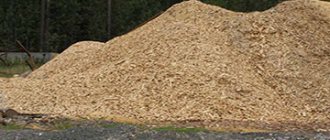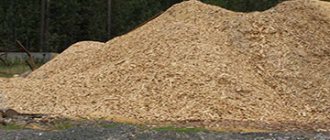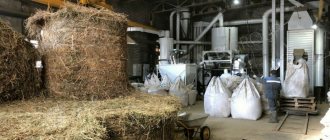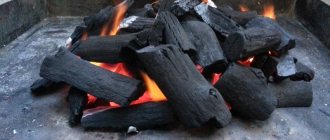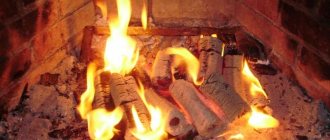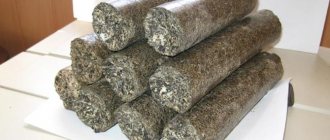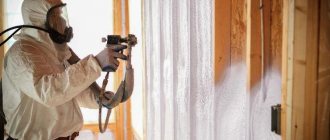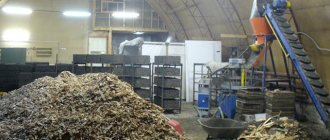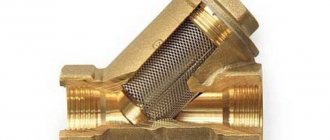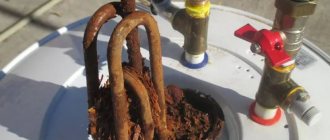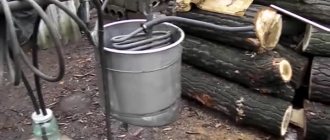Is it possible to make fuel briquettes with your own hands? This question interests many owners of suburban areas today. And it didn’t take long for folk craftsmen to wait and come up with a technology to make fuel from seemingly unnecessary materials that could be used to heat a house, garage, greenhouse, and so on. And such materials can be found at any dacha! This can be not only old boards and sawdust, but also straw, cardboard, paper, dry branches and leaves. And this is not a complete list.
- 1 Strengths and weaknesses of fuel briquettes
- 2 Stage 1. Preparation of the necessary equipment 2.1 Video - Making a press for fuel briquettes
- 5.1 Video – Making fuel briquettes
- 7.1 Video – Industrial production of briquettes
Simply put, what burns can be crushed and used for briquettes. And the chopper itself will not be a problem in this case, because ready-made devices are sold in many stores. This could be, for example, a rotary machine that grinds all materials of plant origin using a set of knives. This kind of machine is relatively cheap, but in our case it will be very helpful at the initial stage of making briquettes. But let's not get ahead of ourselves - first let's get acquainted with some important points.
And here we compare the technical characteristics and cost of fuel briquettes from different manufacturers - read more
Strengths and weaknesses of fuel briquettes
Such fuel can be used not only for solid fuel appliances, but also for stoves or fireplaces. If we talk about the industrial production of briquettes, then the following raw materials are used:
- wood processing waste;
- charcoal;
- straw and various husks;
- peat.
And everything mentioned above is, as you know, renewable natural resources.
Attention! The main advantage of this type of fuel is its environmental friendliness, as well as excellent heat transfer and efficiency.
Moreover, if we compare briquettes with wood, they burn faster, smoke less, due to which the humidity in the air does not increase and remains at the desired level. During combustion, a permanent temperature is maintained and no sparks are formed, and thanks to the correct geometric shape, they are convenient to transport and store.
Of course, there are also disadvantages - for example, briquettes are easily damaged during transportation and have low moisture resistance.
However, if you make fuel briquettes with your own hands, you solve several problems at once:
- heating the house (although, rather, as an additional source, since you are unlikely to be able to prepare the amount of fuel necessary for the winter);
- savings - briquettes will cost practically nothing;
- Finally, by making briquettes, you thereby get rid of various garbage that you could not take to a landfill.
Attention! The most convenient form for briquettes is bricks. Therefore, future technology will be based precisely on this.
We also advise you to look at our article on how to make biofuel on your own
Voting: which solid fuel boiler is the best?
What would you choose from solid fuel boilers or would you recommend purchasing?
Stropuva S40U
16.67 % ( 1 )
Candle S-18kW
16.67 % ( 1 )
Buderus Logano S171-50 W
0.00 % ( 0 )
ZOTA Optima 20
33.33 % ( 2 )
Sime SOLIDA EV 5
0.00 % ( 0 )
Protherm Beaver 40 DLO
16.67 % ( 1 )
Bosch Solid 2000 B SFU 27
16.67 % ( 1 )
Kentatsu ELEGANT-03
0.00 % ( 0 )
Kiturami KRM 30R
0.00 % ( 0 )
ZOTA Mix 20
0.00 % ( 0 )
Stage 1. Preparing the necessary equipment
There are a number of enterprises that specialize in the production and sale of equipment for the production of fuel briquettes. Moreover, such equipment is usually delivered, installed and tested (for an additional fee), and sometimes even trained in proper use.
So, for work you will need:
- device for grinding raw materials;
- drying complex;
- a special press, which can be screw, mechanical or hydraulic.
Of course, if you produce briquettes at home, you can do it without a drying complex, because the finished briquettes can be dried simply in the open air. And if sawdust is used as a raw material, then a chopper is also not needed.
Also take care of a box with cells of the same shape - you can make it yourself from any box by nailing strips of the appropriate sizes to divide it into equal sectors. You will pour the raw materials into these sectors!
Often home craftsmen resort to another option - making their own equipment for pressing.
Video - Making a press for fuel briquettes
Design Basics
In order to make the right - safe, efficient and easy-to-use - solid fuel boiler, it is necessary to understand the physics of the process of its operation and the operation of the heating system as a whole.
Operating principle of a solid fuel heating boiler:
- fuel is loaded into the combustion chamber;
- air and other gases heated during fuel combustion rise upward and are discharged through the chimney;
- on the way to the chimney, the hot air heats the heat exchanger, which in turn heats the thermal agent (in most household heating systems - water);
- the heated thermal agent displaces the cold one, passing through the entire heating system and returning back to the heat exchanger after cooling.
It's all about the property of any heated medium to rise above the cold one - this is one of the fundamental laws of thermodynamics.
Operating principle of a water heating system
To implement this principle, in addition to the body made of thick (at least 4-5 mm) heat-resistant steel, the following elements are included in the design of the solid fuel boiler:
- The combustion chamber
Its volume is determined by a complex formula, which, however, is quite easy to find on the Internet, as well as a ready-made solution - the volume of the combustion chamber in relation to the rated power of the boiler or the maximum heating area.
Firebox location of a solid fuel boiler
In practice, the size of the firebox depends not only on the parameters of the boiler and the properties of the fuel, but also on the characteristics of the heating system itself - schematic, functional complexity, seasonality of operation, peak demand for hot water supply, etc.
- Hot gas exhaust chamber
This unit is a continuation of the combustion chamber and serves as an output manifold for removing combustion products.
Heated gas removal system
- Internal coolant supply and removal system
We are talking about a heat exchanger (heat exchange register), as well as its main pipes - inlet and outlet, which serves to receive cooled thermal agent, heat it and discharge it into the heating system.
Coolant circulation in the solid fuel boiler system
Stage 2. Choosing a room - what should it be like?
And the room should be chosen in such a way that it can not only accommodate all the necessary equipment, but also store raw materials and finished products. The area of such a room directly depends on the scale of future production, but, for example, a minimum of 55-60 m2 is required for pressing.
Attention! When arranging the premises, carefully monitor the quality of ventilation of the area where pressing is planned, as well as the fire extinguishing system and the reliability of electrical networks.
Types of home stoves using solid fuels
It is important to choose the right unit to ensure comfort, safety and ease of use and maintenance of a residential building. The priority type of heating unit is determined at the stage of designing a house, because not every model can be fully implemented into finished housing.
Brick solid fuel stoves are multifunctional and have high efficiency
Brick variations
Here the package includes a firebox, grates, doors, ash chamber, cleanouts, and valves. Types of solid fuel brick stoves:
- direct flow They have a simple device, in which the smoke is directed upward through a straight channel; a prime example is the Russian stove. Disadvantages - large heat losses through the chimney, slow heating of the room,
- countercurrent. The models have a complicated design, here the air supplied from below, during the heating process, moves along the lifting channel, then cools and is directed down through two chimney paths. The body of the device heats up evenly and quickly, it is possible to use a hob, and high efficiency is achieved. Professional calculation and installation required
- duct. They operate on the basis of vertical and horizontal passages; warm air, circulating through them, quickly and fully warms up the room,
- bell-shaped This is the most productive option, here hot gases accumulate in a brick cap, and as they cool, they are forced out into the chimney. It is better to heat such models with coke or coal to minimize operational risks.
Brick products are divided according to design features:
- thin-walled (with a wall thickness of up to 7 cm) begin to warm up the room faster (the effect is noticeable within half an hour), but they are not able to accumulate thermal energy,
- thick-walled (over 12 cm) have significant dimensions and exhibit high heat capacity. It takes 3 hours to warm up the room.
The most popular shapes are polygonal, T-shaped, rectangular, and corner.
Features of metal units
They are safe; modern lines contain tools that allow you to control the heating temperature - automation systems, sensors, control levers. Models are single-circuit and double-circuit (with support for hot water supply).
Common cast iron variations are durable and have high heat capacity, but they are vulnerable to sudden temperature changes. Steel ones are more reliable, but are susceptible to corrosion, and condensation can form on the body.
Long-burning furnaces made of metal are:
- traditional - pyrolysis,
- gas generators. There are two gas-tight chambers with a nozzle between them; fuel is loaded into the lower one. The built-in fan optimizes ignition and combustion.
This segment of devices is characterized by efficiency, decent heat dissipation, and a high level of safety. The latest models that support long-term combustion are equipped with an automatic fuel supply system, and there is a bunker for storing supplies.
Stage 3. Preparation of raw materials
This is the most important stage of the process in which you create your own fuel briquettes. But to work you will need not only waste, but also components such as:
- water in a small amount - only to soften the clay;
- the clay itself will serve as a binder; Note that in industry no additives are used, since the binding element is lignin, a substance released by wood at high pressure, but at home you are unlikely to achieve such pressure, so you will use additional components so that the briquettes “keep their shape.”
Comparison with other types of ovens
One of the key factors due to which preference is given to models operating on solid fuel is the cost of maintenance. Heating costs are lowest when using wood chips, grain, and vegetable pellets. A little more investment will be required for the purchase of wood, brown coal, and wood briquettes (in ascending order). The most expensive heating is based on fuel oil, natural/liquefied gas, or electricity.
| Solid fuel | Natural or liquefied gas | Liquid fuel | Electricity | Solar energy | |
| Heating system type | Water or air | Water | Water | Individual radiators, surface and air heating | Water at low temperature |
| The need for a technical room | No - for fireplaces, yes - for boilers | Yes | Yes | No | Yes, if a thermal accumulator is used |
| The need for a chimney | Yes | Yes | Yes | No | Yes |
| Automatic heating control | Within limited limits | Yes | Yes | Yes | Yes |
| Ease of maintenance | There are difficulties | Comfortable | Comfortable | Comfortable | Comfortable |
| Air pollution level | High | Short | High | Absent | Absent |
Solid fuel heating systems, unlike those that run on natural or liquefied gas or liquid fuel, do not require approval from the settlement administration, a gas supply project and a tank system.
Stage 4. Formation of briquettes
Step 1. First, take the prepared raw materials (sawdust, etc.) and mix it with dry clay. For a kilogram of waste, approximately 100 grams of clay will be required, therefore the ratio will be as follows: 10:1. Add a small amount of water to the resulting mixture and mix everything thoroughly again. Make sure that the mixture is not too thin or too thick - ideally it should stick together perfectly.
Attention! In this case, one should take into account the fact that the density of the finished product depends inversely on the amount of added water. Moreover, if there is too much liquid, the briquettes will take a long time to dry.
You can add some finely chopped paper to the mixture - this will significantly improve combustion.
Step 2. Pour the resulting mixture into prepared molds and compress thoroughly. Try to ensure that the maximum amount of liquid comes out of the products under the press. Leave the briquettes in this form for a while.
Step 3. Next, dry the finished products. For drying, it is advisable to use a firebox, although if you don’t have one, you can do it in the sun. Make sure it dries completely! If the briquettes turn out damp, they will not only not burn, but will also crumble due to their low strength. And in order to somehow increase strength, cover the products with dry leaves or paper when drying.
Step 4. Once the briquettes are completely dry, place them in a previously prepared place and subsequently use them for their intended purpose.
Here's another interesting production option.
Video - Making fuel briquettes
DIY making
Residents of Chinese villages make their own coal briquettes . They take rubber basins and mix the sticky mixture. They form cubes from it using a press on a long handle. After giving the necessary shapes, the materials are dried in the sun. As soon as they are ready, they are placed in a Taganka oven and set on fire.
You can take sawdust and shredded newsprint. This raw material will need to be mixed well. A drill with a special attachment is best suited for this. Next, the resulting mass must be placed in a mold, compacted and covered with a lid. After this, they are pressed using special equipment and dried in the sun.
Sawdust briquettes can be used for heating warehouses, industrial premises, residential premises, and railway rolling stock. This is also a popular option among summer residents and tourists who use European firewood to light barbecues and fires.
Use of other materials
Perhaps there is no need to talk once again about how well the paper burns and how much ash remains after it. For example, a kilogram of compressed paper can burn for about 2 hours, releasing large volumes of thermal energy during this time. At the same time, very little ash remains after this - about 5 percent of the original mass.
Therefore, the question is: is it worth selling waste paper and is it possible to buy firewood with the money received for it? Or is it better to use it in the manufacture of fuel briquettes? In this case, everything is quite complicated, since there are a number of important nuances.
- To make briquettes you will need a lot of paper.
- The paper needs to be shredded somehow, which is extremely difficult - this is not sawdust or firewood! All waste paper will need to be torn into pieces measuring 20x20 millimeters. To do this you will have to use a combine harvester.
- Next, the shredded paper should be filled with warm water. Then you need to wait until the paper transforms into slurry and the solution becomes liquid.
- The remaining water is removed, and the resulting mixture is poured into pre-prepared molds.
- After the mass has gotten rid of all the liquid, the briquettes are removed from the molds and dried in the open air.
From the trash
Attention! Experienced craftsmen who have used the described technology advise adding starch to the paper after filling it with water.
In addition, paper can be used as a binder when fuel briquettes are made with your own hands from wood shavings (we have already mentioned this above). But there are a number of other materials that can perform a similar function - for example, seed husks or pine needles. To be honest, not the best options, but in the absence of an alternative, they are quite suitable. Although they have their drawbacks:
- if the pine needles are very large, then they will have to be chopped using ordinary scissors, and this is very difficult and takes a lot of time; and the pine needles in the finished products will constantly prick your hands;
- with husks there are even more troubles - yes, in the manufacturing process it is quite convenient, but mice love ready-made briquettes made in this way, so in winter you will have a lot of them in your warehouse; rodents will begin to “feast” even at the drying stage, therefore, a large number of products will be hopelessly spoiled.
How a homemade long-burning boiler works
Principle of operation
The operation scheme of such boilers is based on the ability of solid fuel to smolder for several hours, while producing a large amount of thermal energy. It is typical that in this case the fuel is burned more completely, and the amount of waste, as a result, is noticeably reduced.
Boiler drawing
Note! Replacing active combustion with smoldering is possible due to the special design of the heating boiler.
The main element of the boiler is the firebox, where combustion is limited and the intensity of the air supply is controlled using special devices. The fuel is loaded twice a day in large portions, after which it slowly smolders (the limited amount of oxygen does not allow it to burn fully).
The pipe through which the smoke is removed is passed through heat exchangers and heats the liquid in the heating system. It turns out that all you need to do is load fuel every 12 hours for uninterrupted heating of the house.
Boiler diagram
Main advantages
Long-burning boilers stand out from other types of heating systems. Of course, the main advantage is the duration of the work, but there are other important points:
- low fuel cost;
- autonomy;
- the ability to heat large areas at minimal costs;
- ease of installation and operation;
- safety;
- Possibility of making it at home.
Types of solid fuel boilers
Device structure
To make a boiler, it is more convenient to use a metal pipe ø30 cm or larger with a wall thickness of at least 5 mm (otherwise the latter will soon burn out due to the high temperature inside the device). The height of the structure can vary between 80 cm and 100 cm, it all depends on the area of the room.
Housing pipe
Regardless of the modification, the boiler consists of three main zones:
- loading area;
- zones of smoldering and heat generation;
- final combustion zones where ash burns and smoke gases are removed.
Note! The device that limits the loading zone and, accordingly, the smoldering time is called an air distributor.
This element is made in the form of a metal circle 5-6 mm thick with a hole in the middle, through which oxygen is supplied to the firebox using a telescopic pipe. The diameter of the product should be slightly smaller than the diameter of the body. The height is adjusted using a special impeller.
Long burning wood boiler
Long burning wood boiler Expert opinion:
Masalsky A.V.
Editor of the “construction” category on the Stroyday.ru portal. Specialist in engineering systems and drainage.
Typically, the combustion zone does not exceed 5 cm in height - if it is larger, the fuel will burn too quickly. By the way, the oxygen pipe can be not only telescopic, but also solid. Its diameter is usually 6 cm, while the size of the hole in the air distributor does not exceed 2 cm, so as not to saturate the area with oxygen.
Long burning boiler
Air can be supplied in one of two ways:
- straight from the atmosphere;
- from a special heating chamber (it is located in the upper part of the structure), which ensures more efficient operation of the boiler.
A special air damper is used for adjustment.
The chimney pipe is welded on top. It must be perpendicular to the body for at least 0.5 m, otherwise excessive draft will be formed.
A door is equipped at the bottom to remove combustion products. Cleaning should be done infrequently, because the fuel will burn more completely.
There are two ways to heat the coolant, each has its own strengths and weaknesses.
Long burning boiler
Long burning boiler
Method No. 1. A coil is connected to the heat exchanger pipe passing through the combustion zone, through which the water in the tank is heated.
Method No. 2. A separate metal tank is formed, through which the chimney pipe is passed. The hot smoke heats the liquid.
The first method is more effective, but at the same time more difficult to implement. The second one is easier to do, but it is only practical in small houses.
Prices for the range of solid fuel boilers
Solid fuel boilers
Industrial production
If we talk about industrial production, here fuel briquettes are made using one of three possible technologies:
- through hydraulic presses and at high pressure - the result is products that look like small bricks;
- through screw presses under pressure and heat treatment - the result is briquettes that have the shape of an empty polyhedron;
- using hydraulic or mechanical presses at high pressure - as a result, products are cylindrical in shape.
To learn more about this process, watch the thematic video.
Video – Industrial production of briquettes
Spatial diagram and layout of a solid fuel heat generator
The dimensions of a solid fuel boiler depend on the dimensions and spatial orientation of the combustion chamber. Vertical structures have become more widespread, since this arrangement saves space in the boiler room.
Traditional scheme of a vertical solid fuel boiler:
- in the lower part there is an ash pan with a blower;
- A cast iron grate is installed above the ash pan;
- the grate is built into the bottom of the firebox, which must be equipped with a reliable door;
- The working part of the heat exchanger is located above the furnace zone in the plane of greatest thermal contact.
Schematic diagram of a vertical solid fuel boiler
To set up and monitor the operation of the unit during operation, you will need special equipment. These include water temperature sensors at the inlet and outlet of the heat exchanger and heating system components, combustion chamber load sensors, pressure sensors in it and in individual areas of the boiler, etc.
The principle of natural coolant circulation is not always successfully implemented. Therefore, the heating boiler is often equipped with an additional water pump, which forcibly supplies coolant to the heat exchanger and/or to the heating system.
The pump is an energy-dependent unit, which means it is important to provide the ability to bypass coolant supply in case of a power outage. Firstly, so that the heating functions, and secondly, so that the boiler or communications are not broken by steam or damaged by temperature.
If a pump is included in the design of a solid fuel boiler, it is necessary to provide for the possibility of adjusting its operating parameters, as well as emergency shutdown. It is impossible to stop a solid fuel boiler in the event of a breakdown of components and communications of the heating system. Therefore, you need a system for removing excess heat - a shock-absorbing tank with a compensation valve or another solution that is appropriate in your case.
Solid fuel boiler piping
Let's summarize
Do-it-yourself fuel briquettes are inexpensive and at the same time quite effective!
They can be used for heating not only commercial buildings, but also residential buildings. But does it make any sense to make it yourself if briquettes can be purchased in specialized stores? Of course, it does, as always when it comes to making something with your own hands. After all, with a little effort and desire, you can save a lot in winter!
Warm winters and good luck at work!
The cheaper way to heat your home
The price of fuel for heating a private home is of great importance, but it is pointless to consider it in isolation from heat transfer. We will calculate the cost of heating taking into account both parameters.
Combustion of peat fuel 3 hours after laying
In the area where our expert lives, the following prices are asked for proven types of fuel:
- Freshly cut firewood – 20 USD. e. for 1 m³. Let's tie the price to the weight: 20 dollars for 600 kg or 33 cu. e. for 1 ton.
- Briquettes made from pressed sunflower husks – $57 per ton.
- Peat briquette – 84 USD. e./1 t.
It is easy to calculate that 10 kg of wood will cost 33 cents, the rest of the fuel - 57 and 84 cents, respectively. Then 1 hour of heating on wooden logs costs 33 / 1.5 = 22 cents (remember, the wood burned out in an hour and a half).
In a similar way, we determine the hourly rate for burning briquettes:
- pressed husk: 57 / 2.17 (2 hours 10 minutes) = 26 cents;
- briquetted peat: 84 / 3 = 28 cents.
Burning briquetted sunflower seed husks
Interesting result, right? In our case, heating up an absolutely cold building costs 5.28 USD. e. per day for wood, 6.24 dollars for pressed husks and 6.72 cu. e. - on peat “bricks”.
Please note that we took the cost of raw wood (and it will decay sooner) and divided it by the time of full combustion of dry wood. That is, the difference between traditional fuel and briquettes is minimized. We suggest watching the progress of the experiment on video and listening to an expert’s opinion on this matter:
More about briquetting technology
- material from which the briquette is made;
- form;
- security;
- environmental friendliness;
- type of packaging.
You can, of course, burn such dust by first heating the boiler with wood, and then pour the fine fraction on it. But this approach is not a solution; it is very troublesome, because you need to add coal dust little by little, which means often.
If you immediately put a large amount of coal dust on the firewood, it will still spill into the grate and thus, the problem of partial combustion of fuel will not go away, besides, the rest of the dust will fall between the firewood, block the flow of air and the combustion will be significantly weakened.
To circumvent all of the above inconveniences, you need to press coal dust into briquettes, which in this form will burn perfectly, releasing all their energy.
Step by step: how to make briquettes at home
If your goal is not hard work with a good profit, but needs related to heating only your home, purchasing equipment is not very practical. The units cost from 300 thousand to a million, that is, they will not pay off soon. The press can be made manually, by yourself, of your own production. And here there are two options for the development of events - to make a press from scratch, or to use a ready-made existing mechanism.
Of course, it is easier to work with a ready-made mechanism. For example, suppose you have a jack or a hydraulic press. This device must be supplemented with a matrix and a punch. But no matter how cool the press you make with your own hands, it will not be able to achieve the effort required to produce lingin. Therefore, binders will have to be added to the raw materials. The easiest option is cheap wallpaper glue.
You can also add clay in proportions of 1:10; some types of soaked paper are also used. For example, corrugated cardboard - it already contains lingin, and in contact with moisture its fastening properties appear. Interestingly, if we are talking about making briquettes at home, then the material is not dried, but soaked in water for better gluing of the particles. And the finished briquette is dried in the fresh air.
Compost
The simplest and most pure gardening task. Compost fertilizers are always needed and are especially valuable for their natural origin. Since fresh sawdust is not suitable as a fertilizer - they take nitrogen from the soil - you need to make compost from it, or rather add it to where it has already been created. Sawdust helps the main components of the compost mature, and it also warms up faster in the spring. The process can be started from the beginning of summer. Typically, sawdust is placed in compost in layers, which are spilled with water and fertilizers - urea, superphosphate and potassium chloride. It is also recommended to sprinkle each layer with lime. At the end of summer, compost can be used.
Coal briquetting technologies
Coal briquettes are made from brown coal, chips and dust of anthracite and hard coal, semi-coke and coke breeze. Depending on the type of feedstock, binders are added or not.
The formation of briquettes from brown coal occurs without the addition of binders, since the material itself contains up to 20% bitumen. During processing, the raw materials are crushed, heated and dried, bringing the humidity to 18-20%. After cooling, the resulting crumbs are fed into a high-pressure press, where lump fuel is formed. After cooling, they can be used or improved quality characteristics in semi-coking plants.
Coal briquetting press
Briquetting of fine coals can also occur either with or without binders. During industrial production, the following substances are added as a binding element:
- petroleum bitumen;
- lignosulfonates;
- molasses;
- liquid glass;
- cement.
Liquid glass and cement are used in the processing of certain types of coal and fine coke. Such briquettes are used in metallurgy in those processes where the presence of such components is acceptable. Coal tar and petroleum bitumen are also used to produce fuels for industrial applications. Such briquettes are not suitable for heating houses: during combustion, benzopyrene and other harmful substances are released, so they are prohibited by the SES and the demand for them is very limited.
There are two briquetting technologies: with or without the addition of a binder
For briquettes for household use, starches are most often used as a binding element, which are added to the crumbs until a viscous mass is obtained. Sometimes sugar, cellulose, and molasses are added. Clay, gypsum and lime are used less frequently, as they increase the ash content and reduce the specific heat capacity of the fuel. The type and quantity of the binding component is selected based on the qualities of the coal raw material during the production process. The mechanical characteristics of the briquette serve as a guide, but the energy value of the resulting fuel is also important.
The production of coal briquettes for household use consists of the following steps:
- Drying. The less moisture in the raw material, the stronger the briquettes will be.
- Removal of volatile components. This stage is necessary when processing low grade coal containing a large amount of volatile substances. A coke oven or distillation apparatus is used for this.
- Grinding.
- Adding binders and mixing it with coal chips. This composition is called the charge.
- The mixture is fed to a press, where briquettes are formed under pressure.
- In some cases (depending on the binder used), heating in an oven to 300°C is required.
- Cooling.
Developments in recent years have made it possible to form coal briquettes without the use of binders from any waste from the coal industry. Briquetting in such installations takes place in two stages. First, the crushed coal undergoes initial compaction by removing the voids between the particles. Then, by increasing the pressure to 100-200 Mn/m2, the particles themselves are deformed and compacted.
This is what pressed coal looks like
This releases phenols and resins, which, when water is added, form a natural binding component. The entire process is controlled by a microprocessor. The briquettes obtained in this way burn without smoke and do not emit harmful substances. Needless to say, such a coal briquetting press costs a lot? Hence the high cost of the final product. But coal of any brand is processed, the briquettes are strong, with a high calorific value, burn without smoke or any significant emissions into the atmosphere.
The calorific value of coal briquettes is 6000 kcal/k
There are several other technologies that make it possible to make coal briquettes without binders. For this purpose, special roller presses are used, but not all brands are processed in this way. In some developments, some raw materials with a high tar content (caking coals) are added to the high-grade coal crumbs. The resulting mixture is heated to the plasticization temperature of sintered coals, after which the mixture is cooled slightly and then briquettes are formed.
